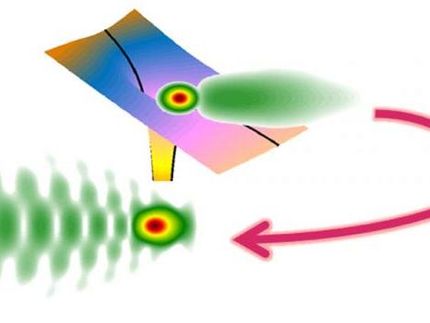New electron source for materials analysis
How can solar cells be made more efficient? How can solar and wind energy be best stored for later use? Technologies for the transformation of the German energy sector (Energiewende) require tailor-made materials which are both affordable and efficient. One important tool in the search for such materials is high-resolution electron energy loss spectroscopy, HREELS for short. This method entails bombarding the material to be investigated with a beam of electrons. The electrons are deflected from the surface of the material and in doing so lose some of their energy. This loss of energy can be measured, thus permitting conclusions to be drawn about the properties of the material, such as its ability to conduct electricity or heat.

The electron source developed by Dr. François C. Bocquet and researchers from the Peter Grünberg Institute – Functional Nanostructures at Surfaces: due to the geometric limitations caused by the use of a hemispherical electron analyser, part of the electron source required a completely new design.
Electron energy loss spectroscopy with parallel readout of energy and momentum", Harald Ibach, François C. Bocquet, Jessica Sforzini, Serguei Soubatch, F. Stefan Tautz, Review of Scientific Instruments, licensed under CC-BY-4.0
HREELS measurements can, however, be very time-consuming. "The really interesting part of the electrons' energy loss is angle-dependent," explains Dr. François Bocquet from Jülich's Peter Grünberg Institute. "This is why it must be measured from different directions. So far, it was only possible to measure the energy loss for one angle at a time. Measurements of a single sample thus took a whole day, and sometimes even longer."
Now, François Bocquet and his colleagues have developed a method for measuring a sample within just minutes. Two additional components in their HREELS instrument simplify the measurements: "The first is a hemispherical electron analyser, which has been successfully used in angle-resolved photoelectron spectroscopy for ten years," says Bocquet. "The second is a modified electron source adapted to the electron analyser, which was developed here at the institute." This is optimized by means of specially developed software which ensures that the electrons in the beam have the desired kinetic energy and can be focused on a very small area of the sample. In this way, the analyser can be used optimally - permitting the simultaneous measurement of energy losses from different angles.
"These innovations enable us to investigate samples which are too unstable or sensitive for the previous methods," explains François Bocquet, whose research is also funded by the Helmholtz Association's Initiative and Networking Fund. The scientists usually work under vacuum conditions so that the surfaces to be investigated are not contaminated. "Since, however, no vacuum is ever perfect, we would have to stop the measurements after a few hours and prepare the sample again. Thanks to the new method, this is now no longer necessary," says a delighted Bocquet.
Original publication
Other news from the department science
Most read news
More news from our other portals
See the theme worlds for related content
Topic World Spectroscopy
Investigation with spectroscopy gives us unique insights into the composition and structure of materials. From UV-Vis spectroscopy to infrared and Raman spectroscopy to fluorescence and atomic absorption spectroscopy, spectroscopy offers us a wide range of analytical techniques to precisely characterize substances. Immerse yourself in the fascinating world of spectroscopy!

Topic World Spectroscopy
Investigation with spectroscopy gives us unique insights into the composition and structure of materials. From UV-Vis spectroscopy to infrared and Raman spectroscopy to fluorescence and atomic absorption spectroscopy, spectroscopy offers us a wide range of analytical techniques to precisely characterize substances. Immerse yourself in the fascinating world of spectroscopy!
























































